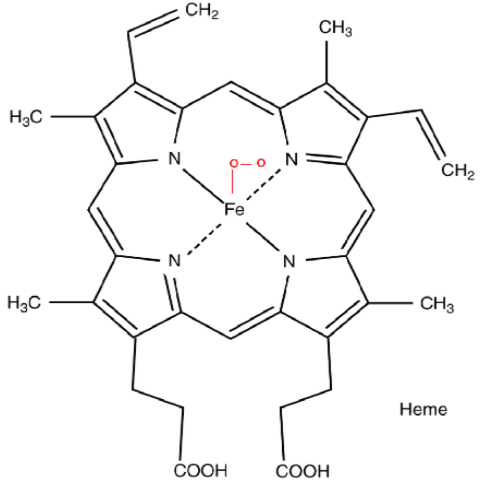
What is oxyhemoglobin and how is it formed?
Answer
492k+ views
Hint: Haemoglobin is the iron-containing pigment present in the blood which is responsible for the red colour of the blood. When the haemoglobin is loaded with oxygen, it forms oxyhaemoglobin. Its role is to transport oxygen to all the cells and tissues of the body.
Complete answer:
The RBC are the blood cells that contain a pigment called haemoglobin which provides red colour to the blood. Haemoglobin is an iron-containing protein that is found in all vertebrates. It mainly transports both oxygen and carbon dioxide from the lungs to tissues and vice versa.
The structure of haemoglobin is a very complex quaternary structure that contains several subunits and globular proteins. The iron occupies the central position at which all the four globular proteins are attached. It is roughly a tetrahedral structure. Each molecule of haemoglobin carries 4 molecules of oxygen and forms oxyhaemoglobin. The iron exists in its ferrous state which oxidises reversibly and temporarily to form oxyhaemoglobin.
During respiration when the oxygen is taken in by the lungs, the alveoli exchange the gases with the blood. This leads to the formation of oxyhaemoglobin. The oxygen as a result of which binds with the heme component or the iron of the haemoglobin. This results in the carrying of oxygen by the blood to all the parts of the body where the cells utilise oxygen to perform several functions and produce energy.
The structure of oxyhaemoglobin is given below.

Note: A normal healthy adult contains around 12-20 gm of haemoglobin per 100 ml of blood. The deficiency of haemoglobin leads to a disease called anaemia. In this, the oxygen is not supplied to all the parts of the body as a result of which the person faces breathlessness and fatigue.
Complete answer:
The RBC are the blood cells that contain a pigment called haemoglobin which provides red colour to the blood. Haemoglobin is an iron-containing protein that is found in all vertebrates. It mainly transports both oxygen and carbon dioxide from the lungs to tissues and vice versa.
The structure of haemoglobin is a very complex quaternary structure that contains several subunits and globular proteins. The iron occupies the central position at which all the four globular proteins are attached. It is roughly a tetrahedral structure. Each molecule of haemoglobin carries 4 molecules of oxygen and forms oxyhaemoglobin. The iron exists in its ferrous state which oxidises reversibly and temporarily to form oxyhaemoglobin.
During respiration when the oxygen is taken in by the lungs, the alveoli exchange the gases with the blood. This leads to the formation of oxyhaemoglobin. The oxygen as a result of which binds with the heme component or the iron of the haemoglobin. This results in the carrying of oxygen by the blood to all the parts of the body where the cells utilise oxygen to perform several functions and produce energy.
The structure of oxyhaemoglobin is given below.

Note: A normal healthy adult contains around 12-20 gm of haemoglobin per 100 ml of blood. The deficiency of haemoglobin leads to a disease called anaemia. In this, the oxygen is not supplied to all the parts of the body as a result of which the person faces breathlessness and fatigue.
Recently Updated Pages
Why are manures considered better than fertilizers class 11 biology CBSE

Find the coordinates of the midpoint of the line segment class 11 maths CBSE

Distinguish between static friction limiting friction class 11 physics CBSE

The Chairman of the constituent Assembly was A Jawaharlal class 11 social science CBSE

The first National Commission on Labour NCL submitted class 11 social science CBSE

Number of all subshell of n + l 7 is A 4 B 5 C 6 D class 11 chemistry CBSE

Trending doubts
10 examples of friction in our daily life

One Metric ton is equal to kg A 10000 B 1000 C 100 class 11 physics CBSE

Difference Between Prokaryotic Cells and Eukaryotic Cells

1 Quintal is equal to a 110 kg b 10 kg c 100kg d 1000 class 11 physics CBSE

State the laws of reflection of light

Explain zero factorial class 11 maths CBSE




